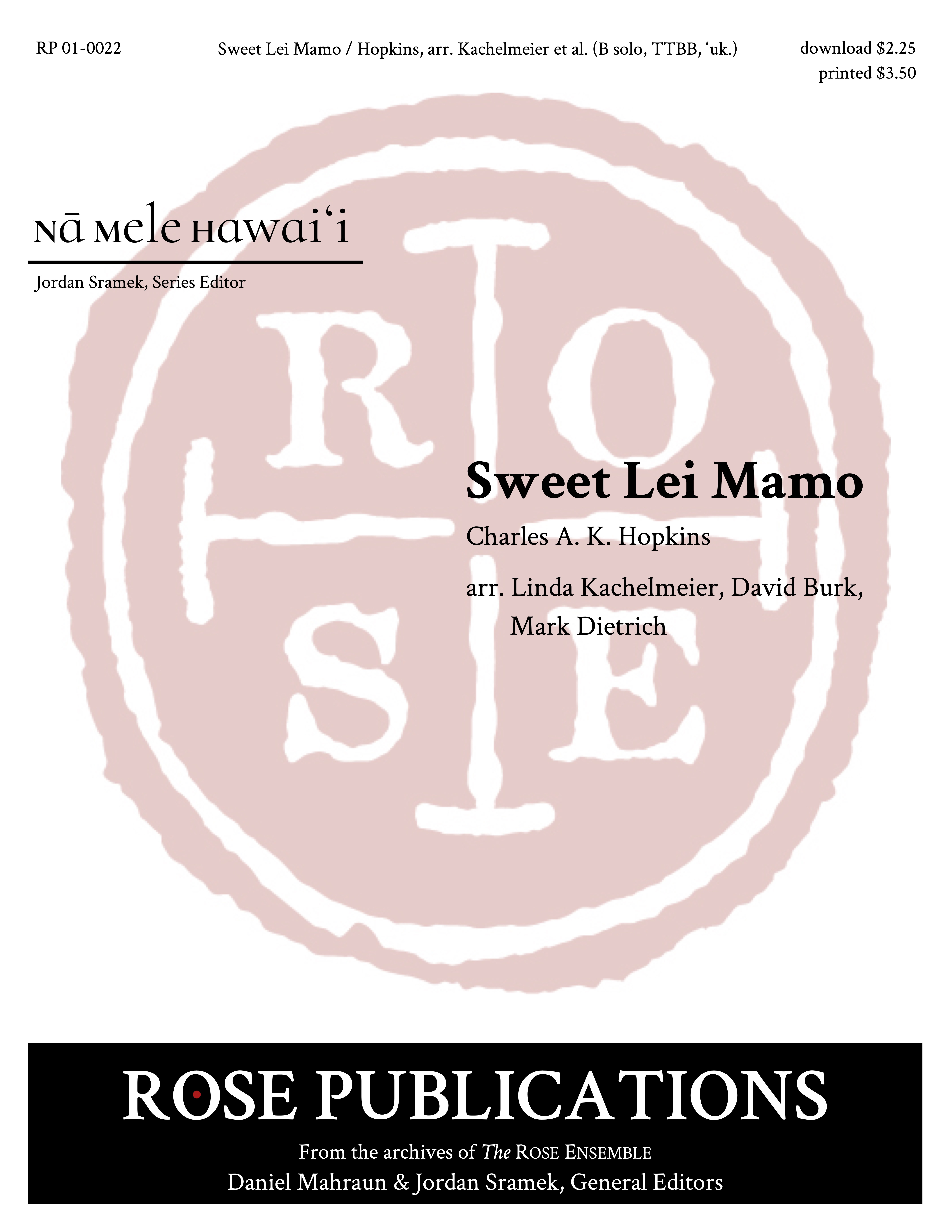You can peruse the score here.
Sweet Lei Mamo
$2.25
Sweet Lei Mamo is written by Charles A.K. Hopkins and arranged by Linda Kachelmeier, David Burk, and Mark Dietrich. It is featured in the Rose Publications Nā Mele Hawai’i: A Rediscovery of Hawaiian Vocal Music series.
From the Series Editor: This rare opportunity for a low bass soloist builds to a final verse in close TB harmony. Given the laid-back and wistful nature of this song, it may be better suited to a smaller ensemble, rather than a full choir. A separate ʻukulele part is included. The score contains source information, historical context, editorial notes, performance suggestions, and a translation above the staff. A brief Hawaiian diction guide is included.
1. Wehiwehi ka uka i ka nahele, Ka popohe lau o ka palai, Hau lipolipo ike onaona, Hoa pili oke ʻaʻaliʻi. Sweet lei mamo, Lei o ke aloha, Kāhiko nani oʻu, Sweet lei mamo.
2. Ka uhi paʻa a ka noe Ka luna ʻolu o Kilohana I laila hoʻi au i ʻike ai Kahi wai huʻi o Leialoha.
3. Honehone leo o ke kāhuli, Leo leʻa o ka waokele Ka ʻiʻiwi ka hoa e like ai, My sweet lei mamo. How charming is the opland forest, Where the palai fern grows in profusion. They’re dark leaved, breathing sweetness So much like the ʻaʻaliʻi. Sweet lei mamo, Lei of love, Beautiful adornment for me, Sweet lei mamo. The thick screen of mist Creeps across lovely Kilohana. It was there that I saw The cold pool of Laʻialoha. Sweet is the voice of the land shell, Happy voice of the damp forest. Their voices are like that of the ʻiʻiwi bird, My sweet lei mamo. -L. U. Huelani
Cattle ranching in Hawaiʻi began in 1793 when Capt. George Vancouver brought cattle on his ship from California to Hawaiʻi as a gift to King Kamehameha I. He advised the King to place a kapu (taboo) on their slaughter for 10 years so they could multiply. (The animals were allowed to roam about freely, multiplying quickly and devouring precious plant life; their numbers grew so dramatically that they became a dangerous nuisance.) Then in 1803, horses were introduced to the Hawaiian Kingdom when Richard Clevedon offered them as a gift to the King. By 1820, the cattle were being hunted for their hides as well as for tallow and meat, which became very important to the Kingdom’s trade activities (the supply of koa and sandalwood trees was already dwindling by this time). As the importance of the cattle trade flourished, there became a great need for handling the animals, so King Kamehameha III brought highly skilled, horse-riding, Mexican vaqueros from Vera Cruz to the Big Island of Hawaiʻi in the 1830s. The term paniolo (cowboy) evolved from the word español (Spanish). Mele Paniolo (cowboy songs) are often accompanied by the guitar (said to have been introduced by Mexican vaqueros), and most commonly extol a cherished place on ranch land.
You may also like…
-
SSA, SA soli, 'ukelele
Moderate
A swaying, loving melody of adoration





